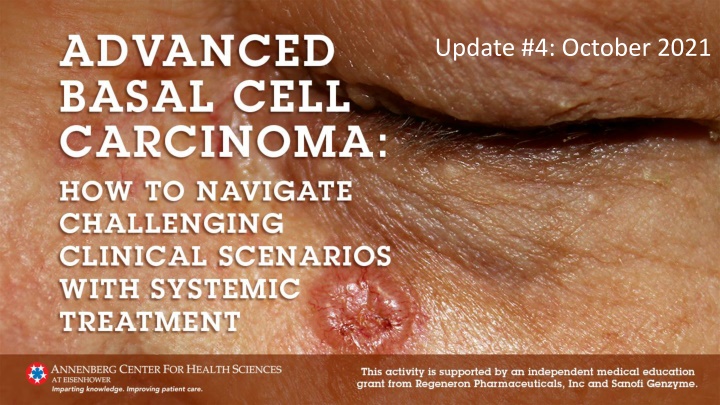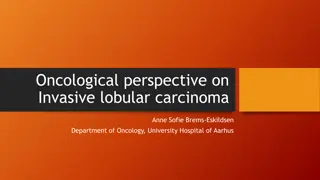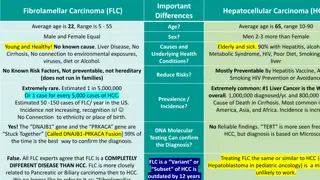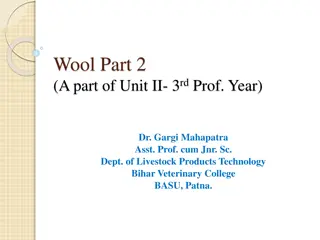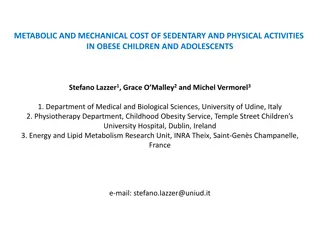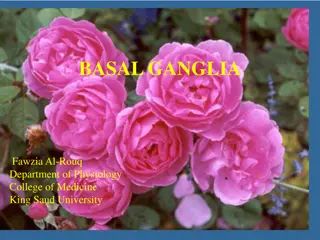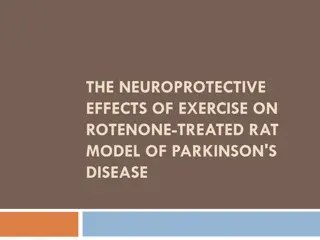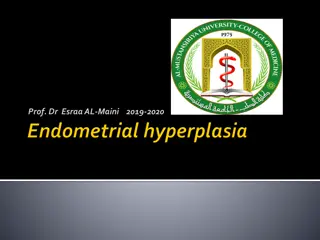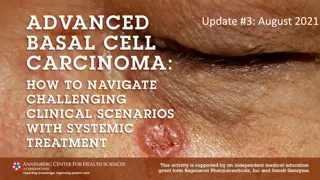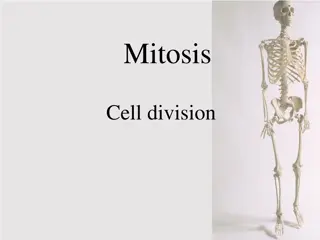New Insights on Locally Advanced Basal Cell Carcinoma Management
The management of patients with locally advanced basal cell carcinoma is rapidly evolving. This update includes key publications focusing on neoadjuvant vismodegib in the treatment of periocular basal cell carcinoma, assessing its impact on surgical excision and histological response. The study shows promising outcomes, including clear margins and minimal side effects. Stay informed on the latest advancements in the field.
Download Presentation

Please find below an Image/Link to download the presentation.
The content on the website is provided AS IS for your information and personal use only. It may not be sold, licensed, or shared on other websites without obtaining consent from the author.If you encounter any issues during the download, it is possible that the publisher has removed the file from their server.
You are allowed to download the files provided on this website for personal or commercial use, subject to the condition that they are used lawfully. All files are the property of their respective owners.
The content on the website is provided AS IS for your information and personal use only. It may not be sold, licensed, or shared on other websites without obtaining consent from the author.
E N D
Presentation Transcript
As in medicine generally, the management of patients with locally advanced basal cell carcinoma is rapidly evolving. To help clinicians keep abreast of new information related to the management of patients with locally advanced basal cell carcinoma, this activity has been updated every 2 months; this is the final of 4 updates. This update includes new information published between August 1, 2021, and September 30, 2021, with a focus on 3 key publications. Links to other publications of potential interest are also provided.
Neoadjuvant vismodegib in the management of locally advanced periocular basal cell carcinoma Curragh DS, et al. Eye (Lond). 2021;35(10):2740-2745.
Neoadjuvant vismodegib in the management of locally advanced periocular basal cell carcinoma Goal: Assess the effect of vismodegib on the extent of surgical excision and histological response Retrospective case series of patients treated with neoadjuvant vismodegib for locally advanced periocular basal cell carcinoma prior to surgical excision Vismodegib continued until maximum clinical response Difference between the estimated surgical margins prior to vismodegib and eventual margins was estimated Curragh DS, et al. Eye (Lond). 2021;35(10):2740-2745.
Neoadjuvant vismodegib in the management of locally advanced periocular basal cell carcinoma (continued) Patients (N=8) were treated for a median of 6 mos Mean follow up 13.4 mos Clinical response in 8/8; partial in 6/8 Complete histological regression in 2/8 Squamous differentiation in 2/8 Final surgical excision achieved clear margins in 8/8 with no recurrence at 13 mos Side effects in 7/8 All resolved on treatment discontinuation Curragh DS, et al. Eye (Lond). 2021;35(10):2740-2745.
Neoadjuvant vismodegib in the management of locally advanced periocular basal cell carcinoma (continued) Conclusions Neoadjuvant vismodegib showed mixed clinical and histopathological response in locally advanced periocular basal cell carcinoma Final surgical excision achieved a reduction in defect size Possible squamous differentiation in 2 cases Curragh DS, et al. Eye (Lond). 2021;35(10):2740-2745.
Key clinical adverse events in patients with advanced basal cell carcinoma treated with sonidegib or vismodegib: A post hoc analysis Gutzmer R, et al. Dermatol Ther (Heidelb). 2021;doi:10.1007/s13555-021-00588-8.
Key clinical adverse events in patients with advanced basal cell carcinoma treated with sonidegib or vismodegib: A post hoc analysis Goal: Describe time to onset and severity of adverse events Patients with histologically confirmed locally advanced or metastatic basal cell carcinoma Setting: 2 studies reporting cumulative adverse event incidence every treatment cycle Sonidegib phase 2 BOLT study: 30-day cycle Expanded-access, open-label vismodegib study: 28-day cycle Treatment Sonidegib 200 mg once daily Vismodegib 150 mg once daily Gutzmer R, et al. Dermatol Ther (Heidelb). 2021;doi:10.1007/s13555-021-00588-8.
Key clinical adverse events in patients with advanced basal cell carcinoma treated with sonidegib or vismodegib: A post hoc analysis (continued) Most adverse events were grade 2 Median time to onset for adverse Most common all-grade adverse events over 18 cycles Adverse Event Sonidegib Vismodegib P events: sonidegib > vismodegib Except fatigue and weight loss (no difference) Conclusion: lower overall incidence and slower onset of certain adverse events with sonidegib vs vismodegib Muscle spasm 54.4% 70.6% .0236 Alopecia 49.4% 58.0% .2469 Dysgeusia 44.3% 70.6% .0003 Diarrhea 31.6% 25.2% .3353 Nausea 39.2% 19.3% .0032 Fatigue 32.9% 19.3% .0429 Weight loss 30.4% 16.0% .0217 Gutzmer R, et al. Dermatol Ther (Heidelb). 2021;doi:10.1007/s13555-021-00588-8.
Effectiveness, safety and utilization of vismodegib in locally advanced basal cell carcinoma under real-world conditions in Germany The non-interventional study NIELS. Gutzmer R, et al. J Eur Acad Dermatol Venereol. 2021;35(8):1678-1685.
Effectiveness, safety and utilization of vismodegib in locally advanced basal cell carcinoma under real-world conditions in Germany The non-interventional study NIELS Goal: Assess effectiveness of vismodegib, with a special focus on duration of response, safety, and utilization Patients with locally advanced basal cell carcinoma who had received 1 dose of vismodegib (N=66) Treatment documented retrospectively/prospectively for 3 y Gutzmer R, et al. J Eur Acad Dermatol Venereol. 2021;35(8):1678-1685.
Effectiveness, safety and utilization of vismodegib in locally advanced basal cell carcinoma under real-world conditions in Germany The non-interventional study NIELS (continued) Objective response rate 74.2% Complete response 37.9% Disease control rate 90.9% Median duration of response 15.9 mos 49/66 (74.2%) with response Median progression-free survival 19.1 mos Median time to response 2.7 mos 340 adverse events reported in 63/66 (95.5%) Serious adverse events: 22 events in 15 patients Conclusion: results in real-world practice are similar to clinical trials Gutzmer R, et al. J Eur Acad Dermatol Venereol. 2021;35(8):1678-1685.
Other Publications Dunmann K, et al. Complete remission of basal cell carcinoma following treatment with cemiplimab after 2 years. JAMA Dermatol. 2021;157(8):1004-1006. Grob JJ, et al. Position statement on classification of basal cell carcinomas. Part 1: unsupervised clustering of experts as a way to build on operational classification of advanced basal cell carcinoma based on pattern recognition. J Eur Acad Dermatol Venereol. 2021;35(10):1949-1956. Patel AD, et al. Hedgehog inhibitors with and without adjunctive therapy in treatment of locally advanced basal cell carcinoma. Int J Dermatol. 2021;doi:10.1111/ijd.15836 Xavier C, et al. Vismodegib for treatment of periocular basal cell carcinoma 6-year experience from a tertiary care center. An Bras Dermatol. 2021;S0365-0596(21)00219.
